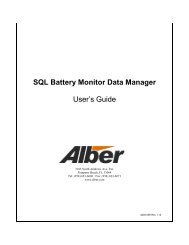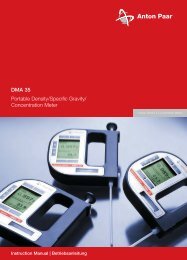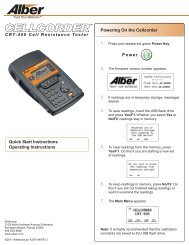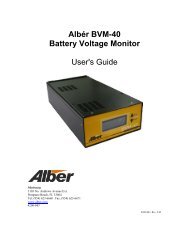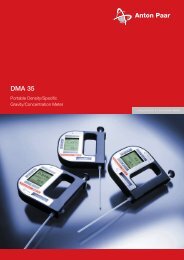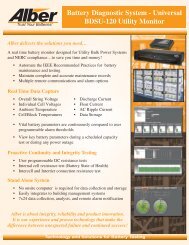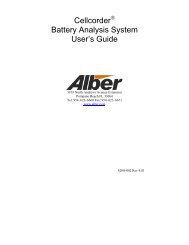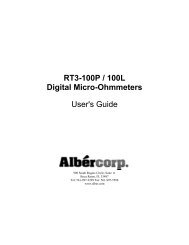MLC Monitor Load Control User's Guide - Alber
MLC Monitor Load Control User's Guide - Alber
MLC Monitor Load Control User's Guide - Alber
Create successful ePaper yourself
Turn your PDF publications into a flip-book with our unique Google optimized e-Paper software.
General Description1 General DescriptionThe <strong>Monitor</strong> <strong>Load</strong> <strong>Control</strong> <strong>MLC</strong> battery capacity testing system helps ensure the reliability of theDC bus by determining weaknesses in the battery string and estimating when the battery shouldbe replaced. Capacity testing is the only proven way to determine where the battery is in its lifecurve. The <strong>MLC</strong> allows the user to determine the amount of energy remaining in the battery.The test system can also help detect faulty intercell connections and weak cells in the batterystring.During a battery discharge test, the <strong>MLC</strong> continuously records and displays individual cellvoltages, overall battery voltage, current, and alarm parameters. Test data can be printed usingthe report generator or exported to other programs.The <strong>MLC</strong> monitors and displays the voltage of up to 256 cells or modules, and up to eightstrings. It can be programmed to discharge a battery under constant current, constant power(KW), or variable current (user defined) profile conditions, and has programmable alarm warningand shut down levels. The <strong>MLC</strong> controls battery discharge tests at currents up to 4000 amps,and can print data reports upon completion of the discharge test.Data logging is accomplished with a memory-saving write-by-exception method, which internallyrecords monitored parameter changes that exceed 5 millivolts and stores all data on the harddrive.2 System RequirementsThe following are the minimum requirements for <strong>MLC</strong> and BCT―2000 system operation:¤ Microsoft Windows 2000 or XP,¤ Pentium4 1GHz or higher microprocessor,¤ 128M of memory for Windows 2000, 256M for Windows XP,¤ 150M of hard disk space for program installation. 1G of space for data storage,¤ CD/DVD drive, and a¤ USB port.NOTE:The <strong>MLC</strong> program must be installed on a computer that has the Albércorp Battery<strong>Monitor</strong> Data Manager (BMDM) program installed. The <strong>MLC</strong> uses the same databasethat the BMDM program uses.3 Software InstallationThe <strong>MLC</strong> software program controls all aspects of the <strong>MLC</strong> system.Setup information is saved to the database that was last opened under the BMDM program.This file contains calibration, setup, configuration, and password information. Calibrationinformation is stored in the hardware.The <strong>MLC</strong> program is packaged with the BMDM program. Both programs are installed from theBMDM CD.To start the <strong>MLC</strong> program, double-click the <strong>MLC</strong> icon on the desktop.On an 800 x 600 window, the Windows taskbar hides a portion of some <strong>MLC</strong> windows. Eitherdrag the taskbar to minimize it, or right click on the taskbar, then select Properties|Auto Hideto hide the taskbar.4200-020R2.0 1 9/25/2009



